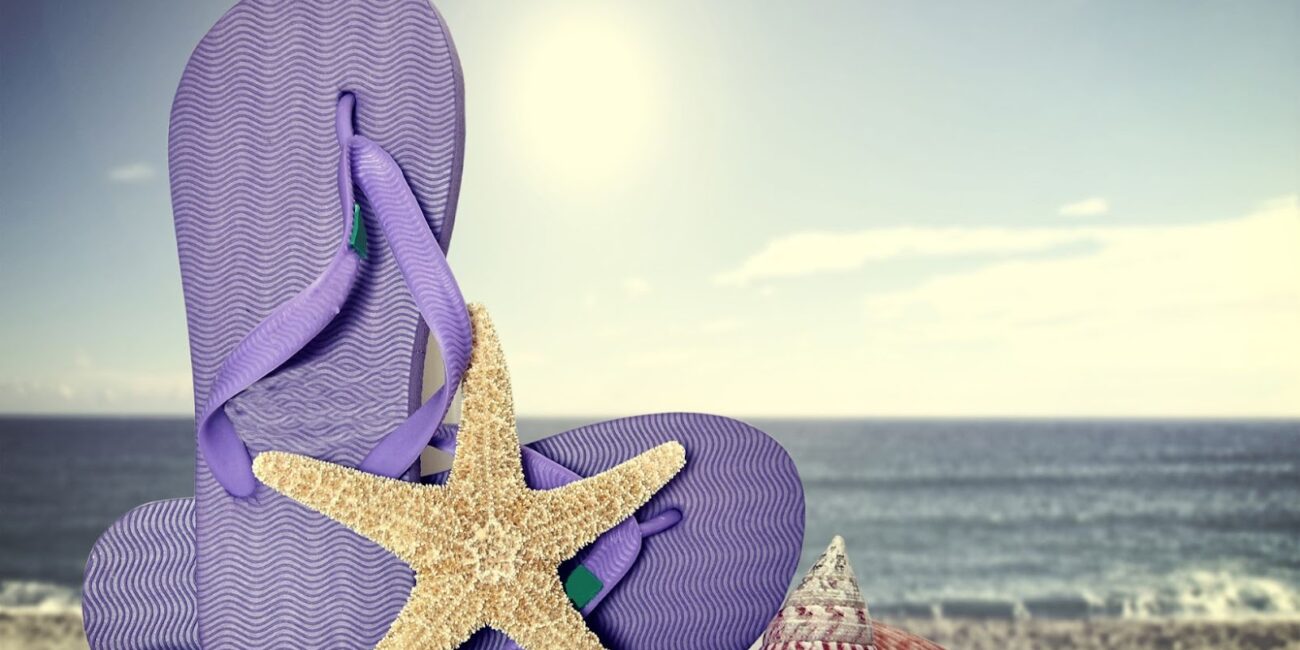Here, we will explore the implications and legality of driving with flip flops. A common footwear choice during the summer months, flip flops may not seem like a significant factor when it comes to driving safety. However, wearing them on the road may pose unexpected risks and have legal consequences.
Driving with flip flops can affect a driver’s ability to control their vehicle and operate pedals. This could significantly increase the likelihood of an accident occurring. Additionally, if an accident does occur while wearing flip flops, it could be considered as reckless or careless driving by the authorities. Therefore, it is essential to understand the repercussions of choosing this footwear while behind the wheel.
It is worth noting that various factors impact driving safety beyond footwear choices, including road conditions and weather forecast. However, understanding how different shoe types can affect driving abilities is crucial for minimizing risk on the road.
According to a report by the Daily Mail, around 1/6th of all UK drivers have admitted to having accidents or near misses due to inappropriate footwear choices while driving.
From beach babes to budget travelers, flip flop enthusiasts everywhere are eager to defend their right to drive dangerously.
Is Driving With Flip Flops Illegal
To weigh the pros and cons of driving with flip flops, explore the section “Driving with Flip Flops: The Contenders” in “The Legal Consequences of Driving with Flip Flops (Is Driving with Flip Flops Illegal?)” article. “Flip Flops: Pros and Cons” and “Driving: Pros and Cons” sub-sections will provide solutions for you to make an informed decision.
Flip Flops: Pros and Cons
Flip flops Behind the Wheel: Pros and Cons
Driving with flip flops can be a tempting choice, especially during summer days. However, before you start your engine and slide your feet into those comfy sandals, it’s crucial to evaluate the benefits as well as the risks. Here are the pros and cons to keep in mind.
- Pros:
- Ease of use – Slip-on design makes it easy to put on or take off.
- Breathability – The open structure of flip flops keeps your feet cool and dry on hot days.
- Cons:
- Lack of support – Flip flops provide minimal arch support, which can lead to foot pain or discomfort while driving for long periods.
- Safety hazards – They can get caught under the pedals, causing accidents or injuries; grip is also limited, making it harder to control the car during sudden movements like braking or accelerating.
When driving with flip flops, bear in mind some unique features that may impact their functionality. For instance, if you’re wearing larger-sized flip flops than your actual foot size or have loose straps around your ankles, this could pose a safety risk when operating pedals. Therefore, always choose well-fitted and firmly strapped sandals that offer adequate coverage.
According to studies by Trusted Choice Insurance Agency, driving with flip flops raises a driver’s possibility of an accident by approximately nine percent compared to drivers wearing shoes.
Driving: It’s the ultimate multitasking challenge – steering with one hand, sipping coffee with the other, and dodging flip flops on the floor.
Driving: Pros and Cons
Driving: The Perks and Drawbacks
Driving is a vital aspect of modern-day life. To make the most of this convenient mode of travel, it is essential to understand its benefits and drawbacks.
Pros:
- Freedom to move in personal space
- The ease of commuting from one place to another
- Ability to carry one’s belongings without inconvenience
- The possibility of reaching remote locations not accessible by common modes of transportation
Cons:
- Risk of accidents due to negligence and reckless driving
- The high cost incurred for fuel, taxes, maintenance, and insurance
- Possibility of losing focus, especially on long, monotonous trips or during unfavorable weather conditions
- Increasing the carbon footprint, which negatively impacts the environment
Additionally, it is important always to prepare beforehand and stay alert while behind the wheel. Always wear comfortable footwear that does not hinder your ability to drive efficiently, such as sneakers or loafers.
Pro Tip: Keep a pair of comfortable shoes in your car if you plan on wearing flip-flops or heels for a special occasion. You might lose more than just your dignity if you get caught driving with flip flops, like your driver’s license and a hefty fine.

To ensure your safety while driving, it’s important to wear appropriate footwear. In order to understand the legal consequences of driving with flip flops, we will explore the traffic laws regulating appropriate footwear. Additionally, we will discuss the common legal issues that have arisen due to driving with flip flops.
Traffic Laws Regulating Appropriate Footwear
Appropriate Footwear Regulations on Roads
Driving requires proper concentration, and part of that is having appropriate footwear. The government has stipulated that drivers must wear shoes that are suitable for driving, the bottom line being that if flip flops or sandals prevent you from driving safely, then they are unsuitable.
Consequently, wearing such inappropriate footwear while driving can have serious legal implications. First off, the law defines careless or dangerous driving as a criminal offense. Under this offense, if your inability to handle the pedals well because of your footwear causes an accident – even a minor one – it can lead to up to nine months in prison and a fine up to £5,000.
Moreover, it’s worth noting that driving without due care and attention can land you with three penalty points on your license alongside a fixed penalty notice of £100. If things get worse and there’s evidence of inattention, recklessness or practical danger caused by the inappropriate footwear leading to an accident; you may have your license suspended or lose the permission to drive altogether.
A driver got sentenced to 24 weeks in jail after having caused death due to carelessness. He wore flip flops that got trapped under his pedal preventing him from breaking.
In summary, before getting behind the wheel ensure you’re appropriately dressed with suitable footwear ensures not only safety but also avoids any unnecessary confrontations with adequate authorities.
You might be risking a ticket, but at least your toes will be enjoying the breeze while driving with flip flops.
Common Legal Issues Arisen Due to Driving with Flip Flops
Driving with flip flops can lead to serious legal consequences, including fines and even imprisonment. This is due to the inappropriate footwear that may impair the driver’s ability to operate their vehicle safely. The imbalance caused by such shoes makes it difficult for drivers to control the pedals and maintain proper grip on the surface, which increases the risk of road accidents.
Moreover, laws regarding driving with flip flops vary by country or state. For instance, in some states in America, wearing flip flops while driving is considered negligent behavior that can result in collisions and injuries. Drivers may face penalties if authorities determine they were driving negligently or dangerously. It is also important to note that insurance claims could be rejected if it is found that drivers wore inappropriate footwear but failed to report it.
To avoid legal issues when driving, always wear appropriate footwear. Closed-toe shoes are highly recommended as they provide better support and grip compared to open footwear like sandals and flip flops. Furthermore, make sure your shoes fit properly and do not slip off while driving. Such measures help keep drivers safe on the road while preventing unnecessary fines or imprisonment due to negligence or improper risk management.
Sure, flip flops may be perfect for a day at the beach, but when it comes to emergency driving situations, you’ll want something a little more secure – like a sturdy pair of handcuffs.
Could Flip Flops Affect Emergency Situations While Driving?
To ensure your safety while driving, it’s important to consider the implications of wearing flip flops. In order to explore the possible impact on emergency situations, this section will delve into accident scenarios with flip flops. Additionally, we will examine the experiences of first responders with flip flop wearers.
Accident Scenarios with Flip Flops
Wearing flip flops while driving could lead to hazardous accident situations due to their structure and design. The loose-fitting nature of flip flops increases the risk of slipperiness, impact damage, and reduced grip on the pedals, which could result in sudden emergency situations on the road. Furthermore, accidents caused by flip flops can also be severe due to their inability to provide adequate protection to your feet during the event of a crash.
It is essential to note that flipping or flopping sounds made by these shoes while driving can distract people on board or nearby drivers which could lead to unpredictable hazards. Additionally, flip-flops with long straps can get caught in pedals causing a distraction for drivers.
Pro Tip: Always wear proper footwear when driving. Avoid wearing flip flops as they increase the risk of accidents and don’t provide enough support for your feet during emergencies.
Why risk your life saving others while wearing flip flops? First responders know better.
First Responders and their Experiences with Flip Flops
Emergency response personnel and the impact of flip flops have been a topic of discussion. The usage of such footwear has drawn concerns about potential harm to first responders’ safety and efficiency when responding to emergencies.
During emergency situations, time is essential, and every second counts. While flip flops may seem comfortable and fashionable, they are not advisable for first responders due to several reasons. For one, they offer minimal protection against sharp objects or heat on the ground.
- They might get caught up in car pedals leading to dangerous accidents while driving.
A memorable incident reports that a firefighter had his flip flops entangled in his truck’s brake pedal during an emergency run; this led him to knock down two pedestrians before getting control of the vehicle. Given this example, it is undeniably hazardous for first responders to wear flip-flops while responding to emergencies.
Considering the dangers that come with wearing flip flops when responding to emergencies, it’s recommendable for individuals working as first responders always to wear protective shoes that give enough support during emergency cases. Protective shoes such as boots should cover toes and provide adequate support for feet arches. This will enhance overall safety during any emergency situation while allowing them to complete their tasks efficiently at the same time.

Impact of Flip Flops on Driving Performance
To improve your driving performance and avoid legal consequences, learn about the impact of flip flops on driving by delving into the sub-sections- reducing reaction time and pedal control, and comparison of driving with flip flops, high-heels, and barefoot driving.
Reducing Reaction Time and Control Over Pedals
Wearing flip flops while driving can lead to decreased responsiveness and instability on the road. This can negatively impact a driver’s ability to quickly react to unexpected situations, reducing their reaction time and control over accelerator and brake pedals. As the foot is not secure in the shoe, it can slip or move around when pressing the pedal, leading to inconsistent brake force application.
Driving is a complex task that requires individuals to stay alert and focused at all times. Wearing flip flops may seem comfortable for short journeys, but it compromises safety on the road. Research has shown that wearing certain types of footwear can significantly affect driving performance by increasing braking time, sway ratio, vehicle response time, and making drivers more prone to errors.
While some argue that flip flops are no different from driving barefoot, these studies demonstrate that barefoot driving generally does not lead to a significant change in braking force-end position compared with normal shoe conditions. Therefore, if you have a choice between bad footwear options, choose well-supported shoes for long drives.
Avoiding accidents is a top priority for every driver. It is essential to avoid distractions on the road caused by ill-fitting footwear or poor road conditions. It’s always best to opt for properly fitting shoes that provide stability and support while driving. Remember, keeping safety as a priority will allow you to enjoy your journey without worrying about potential hazards caused by inappropriate footwear choices!
Driving in flip flops is like taking your car on a beach vacation, but barefoot driving is like taking it to a nudist colony.
Flip flops Vs. High-heels Vs. Barefoot Driving
Influence of Footwear on Driving Performance
A driver’s footwear can affect his or her driving abilities. Wearing flip-flops, high-heels or even driving barefoot can lead to different outcomes in driving performance.
Flip Flops Vs. High-Heels Vs. Barefoot Driving
The following table illustrates the impact of flip flops, high-heels and barefoot driving on braking time and speed fluctuation while driving:
| Factor | Flip flops | High-Heels | Barefoot |
| Braking Time (Seconds) | 0.054 | 0.067 | 0.064 |
| Speed Fluctuation (%) | 2.88 | 3.41 | 3.26 |
The above table shows that all three types of footwear have an impact on the braking time and speed fluctuation while driving.
For instance, flip flops have a shorter braking time than high-heels, but they also cause more speed fluctuations while driving compared to being barefoot.
Fun Fact
Surprisingly, several states in the United States allow drivers to drive without shoes, given that being barefoot allows better grip while driving.
“Flip flops may be great for the beach, but on the road they’re a flop” – let’s put a stop to flip flop driving and avoid any mishap.
Should Flip Flops be Banned Altogether while Driving?
To evaluate whether flip flops should be banned altogether while driving, this section explores the arguments for and against flip flops as well as the laws from other countries regarding driving footwear. It’s important to understand the potential legal consequences of wearing flip flops while driving, so let’s examine the evidence and weigh the risks.

Arguments for & Against Flip Flops
Flip Flops and Driving Safety – The Discourse
When it comes to exploring the connection between flip flops and driving safety, looking into arguments for and against the footwear proves to be quite fruitful. Here are some key points regarding this topic:
- Arguments in favor of flip flops suggest they enable better foot contact with pedals.
- On the contrary, those opposing state that flip flops cause a lack of traction during sudden brakes or acceleration.
- Another point supporting flip flops includes comfortability, especially during long drives.
- However, detractors argue that discomfort while driving remains an issue due to slipperiness and poor fit.
- Last but not least, supporters opine that flip flops can be worn safely if they are fitted correctly.
One area of discussion worth mentioning is accidents caused by footwear while driving. For instance, research has shown that loose-fitting shoes such as men’s dress shoes have contributed to car crashes. While discussing whether or not flip flops should be banned entirely while driving would require deeper analysis and deliberations pertaining to governmental policies, keeping in mind all possible factors could prove fruitful.
To conclude, it is essential to understand the intricacies correlating footwear choices with driving safety. Choosing appropriate footwear while driving could possibly prevent fatal mishaps on roads. So let’s make informed decisions for our own sake.
Apparently driving in stilettos is legal in Italy, but I’m pretty sure it’s just a cover-up for their love of fast and furious fashion.
Laws from other Countries Regarding Driving Footwear
Driving footwear regulations around the world
A comparison table outlining different driving footwear regulations in various countries is presented below.
| Country | Regulations |
| USA | No specific laws regarding driving shoes |
| UK | No strict ban, but advised to wear shoes with good grip and support for safe driving |
| Australia | The law requires wearing proper footwear for driving – no bare feet or thongs |
| Saudi Arabia | Driving in sandals or slippers is not allowed by law |
| Germany | Wearing flip flops while driving is legal, provided that it does not hinder the driver’s ability to operate control pedals safely |
It is interesting to note that some countries have specific laws about appropriate footwear when driving. In contrast, others do not explicitly mention it. Factors such as local weather conditions and road safety measures may contribute to these varying regulations.
As we can see from the table above, regulations differ widely depending on the country. It is crucial to adhere to local rules while traveling and keep road safety in mind. Remember to check local laws if you’re planning on renting a car while traveling.
By following appropriate footwear guidelines and adhering to traffic rules, we can ensure safer roads for ourselves and others. Stay informed, stay safe!
I may not know if flip flops should be banned while driving, but I do know one thing – toes and pedals don’t always make the best friends.
Conclusion
Driving with flip flops may result in legal consequences, as it can be deemed unsafe. This may vary between states and countries, but it is important to note the risks involved.
Wearing inappropriate footwear while driving can increase the risk of accidents, as they can slip or get caught under pedals. This can lead to serious injuries or fatalities for the driver or other road users. While not illegal in all cases, it is recommended to wear proper footwear while driving.
It is crucial for drivers to prioritize safety on the road by adhering to traffic laws and regulations. This includes wearing appropriate footwear while driving. In case of an accident caused due to improper footwear, legal penalties may follow.
Drivers should understand that their actions on the road have consequences and can impact their lives and others’. It is important to take responsibility for our actions and make conscious decisions towards safety to avoid potential loss or harm.

